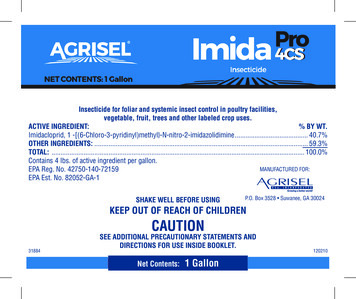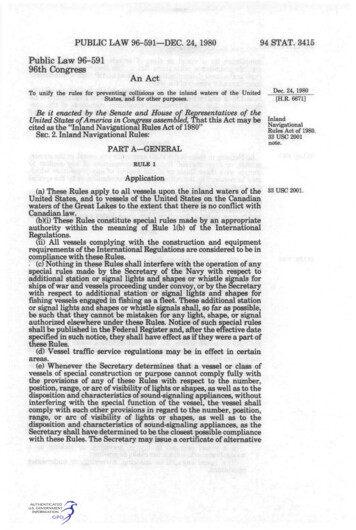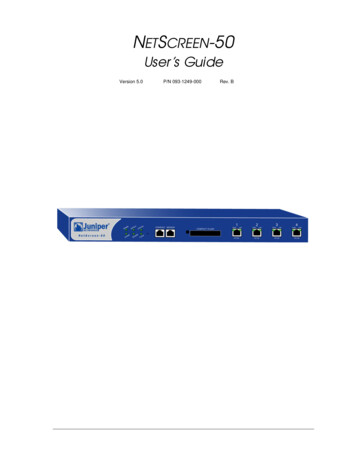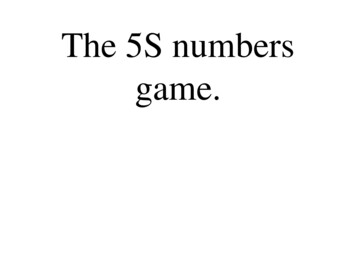
Transcription
InsecticideInsecticide for foliar and systemic insect control in poultry facilities,vegetable, fruit, trees and other labeled crop uses.Active Ingredient: % BY WT.Imidacloprid, 1 idimine. 40.7%OTHER INGREDIENTS:. 59.3%TOTAL: . 100.0%Contains 4 Ibs. of active ingredient per gallon.MANUFACTURED FOR:EPA Reg. No. 42750-140-72159EPA Est. No. 82052-GA-1SHAKE WELL BEFORE USINGP.O. Box 3528 Suwanee, GA 30024KEEP OUT OF REACH OF CHILDRENCAUTION31884SEE ADDITIONAL PRECAUTIONARY STATEMENTS ANDDIRECTIONS FOR USE INSIDE BOOKLET.Net Contents:1 Gallon120210
FIRST AIDIF SWALLOWED: Call a poison control center or doctor immediately for treatment advice. Have a person sip a glass of water if able to swallow. Do not inducevomiting unless told to do so by a poison control center or doctor. Do not give anything by mouth to an unconscious person.IF ON SKIN OR CLOTHING: Take off contaminated clothing. Rinse skin immediately with plenty of water for 15 - 20 minutes. Call a poison control center ordoctor for treatment advice.IF IN EYES: Hold eye open and rinse slowly and gently with water for 15 - 20 minutes. Remove contact lenses, if present after the first 5 minutes, then continuerinsing eye. Call a poison control center or doctor for treatment advice.IF INHALED: Move person to fresh air. If person is not breathing, call 911 or an ambulance, then give artificial respiration, preferably mouth-to-mouth ifpossible. Call a poison control center or doctor for further treatment advice.In case of emergency call CHEMTREC toll free at 1-800-424-9300.Have the product container or label with you when calling a poison control center or doctor or going for treatment.NOTE TO PHYSICIAN: No specific antidote is available. Treat the patient symptomatically.PRECAUTIONARY STATEMENTSHAZARDS TO HUMANS AND DOMESTIC ANIMALSCAUTIONHarmful if swallowed, absorbed through skin, or inhaled. Avoid contact with skin, eyes or clothing. Avoid breathing vapor or spray mist.Wash thoroughly with soap and water after handling. Remove contaminated clothing and wash before reuse.PERSONAL PROTECTIVE EQUIPMENT (PPE)Applicators and other handlers must wear: Long-sleeved shirt and long pants Chemical-resistant gloves made of any waterproof material such as barrier laminate, butyl rubber, nitrile rubber, neoprene rubber, natural rubber, polyethylene,polyvinylchloride (PVC), or Viton Shoes plus socksFollow manufacturer’s instructions for cleaning/maintaining personal protective equipment, PPE. If no such instructions for washables exist, use detergent andhot water. Keep and wash PPE separately from other laundry.ENGINEERING CONTROLS STATEMENTWhen handlers use closed systems, enclosed cabs, or aircraft in a manner that meets the requirements listed in the Worker Protection Standard (WPS) foragricultural pesticides [40 CFR 170.240(d)(4-6)], the handler PPE requirements may be reduced or modified as specified in the WPS.USER SAFETY RECOMMENDATIONSUsers should: Wash hands before eating, drinking, chewing gum, using tobacco, or using the toilet. Remove clothing/PPE immediately if pesticide gets inside. Then wash thoroughly and put on clean clothing. Remove PPE immediately after handling this product. Wash the outside of gloves before removing. As soon as possible, wash thoroughly and change intoclean clothing.ENVIRONMENTAL HAZARDSDo not apply directly to water, to areas where surface water is present, or to intertidal areas below the mean high water mark. Do not contaminate water whendisposing of equipment washwaters.This product is highly toxic to bees exposed to direct treatment or residues on blooming crops or weeds. Do not apply this product or allow it to drift to bloomingcrops or weeds if bees are visiting the treatment area. This product is toxic to wildlife and highly toxic to aquatic invertebrates.This chemical demonstrates the properties and characteristics associated with chemicals detected in ground water. The use of this chemical in areas where soilsare permeable, particularly where the water table is shallow, may result in ground water contamination.TAKE THE FOLLOWING PRECAUTIONS WHEN MIXING AND APPLYING IN THE VICINITY OF AQUATIC AREAS SUCH AS LAKES, RESERVOIRS, RIVERS,PERMANENT STREAMS, MARSHES OR NATURAL PONDS, ESTUARIES, AND COMMERCIAL FISHING PONDS.2
SPRAY DRIFT MANAGEMENTThe interaction of many equipment- and weather-related factors determine the potential for spray drift. The applicator is responsible for considering all of thesefactors when making application decisions. Avoiding spray drift is the responsibility of the applicator.For Aerial ApplicationsFor aerial applications, mount the spray boom on the aircraft so as to minimize drift caused by wing tip vortices. Use the minimum practical boom length, donot exceed 75% of the wing span or rotor diameter. Release spray at the lowest possible height consistent with good pest control and flight safety. Do not makeapplications more than 10 feet above the crop canopy.Importance of Droplet SizeAn important factor influencing drift is droplet size. Small droplets ( 150-200 microns) drift to a greater extent than large droplets. Within typical equipmentspecifications, applications should be made to deliver the largest droplet spectrum that provides sufficient control and coverage. Formation of very small dropletsmay be minimized by appropriate nozzle selection, by orienting nozzles away from the airstream as much as possible and by avoiding excessive spray boompressure.Wind Speed RestrictionsDrift potential increases at wind speeds of less than 3 mph (due to inversion potential) or more than 10 mph. However, many factors, including droplet size,canopy, and equipment specifications determine drift potential at any given wind speed. Do not apply when winds are greater than 15 mph and avoid gusty andwindless conditions. Risk of exposure to sensitive aquatic areas can be reduced by avoiding applications when wind direction is toward the aquatic area.Restrictions During Temperature inversionsDo not make aerial or ground applications during temperature inversions. Drift potential is high during temperature inversions. Temperature inversions restrictvertical air mixing, which causes small suspended droplets to remain close to the ground and move laterally in a concentrated cloud. Temperature inversions arecharacterized by increasing temperature with altitude and are common on nights with limited cloud cover and light to no wind. They begin to form as the sunsets and often continue into the morning. Their presence can be indicated by ground fog; however, if fog is not present, inversions can also be identified by themovement of smoke from a ground source. Smoke that layers and moves laterally in a concentrated cloud (under low wind conditions) indicates an inversion,while smoke that moves upward and rapidly dissipates indicates good vertical mixing.Mixing and Loading RequirementsTo avoid potential contamination of groundwater, the use of a properly designed and maintained containment pad for mixing and loading of any pesticide intoapplication equipment is recommended. If containment pad is not used, maintain a minimum distance of 25 feet between mixing and loading area and potentialsurface to groundwater conduits such as field sumps, uncased well heads, sinkholes, or field drains.Airblast (Air Assist) Specific Instructions for Tree Crops and VineyardsAirblast sprayers carry droplets into the canopy of trees/vines via a radially- or laterally-directed airstream. Follow the following spray drift management practices: Adjust deflectors and aiming devices so that spray is only directed into the canopy. Block off upward pointed nozzles when there is no overhanging canopy. Use only enough air volume to penetrate the canopy and provide good coverage. Do not allow the spray to go beyond the edge of the cultivated area (i.e., turn off sprayer when turning at end rows). Only spray inward, toward the orchard or vineyard, for application to the outside rows.No-spray Zone Requirements for Soil and Foliar ApplicationsDo not apply by ground within 25 feet or by air within 150 feet of lakes, reservoirs, rivers, permanent streams, marshes or natural ponds, estuaries, andcommercial fish farm ponds.Runoff ManagementDo not cultivate within 10 feet of the aquatic areas to allow growth of a vegetative filter strip. When using ImidaPro 4SC on erodible soils, employ the BestManagement Practice for minimizing runoff. Consult your local Natural Resources Conservation Service for recommendations in your use area.Endangered Species NoticeUnder the Endangered Species Act, it is a federal offense to use any pesticide in a manner that results in the death of a member of an endangered species. Consultyour local county bulletin, County Extension Agent, or Pesticide State Lead Agency for information concerning endangered species in your area.Resistance ManagementSome insects are known to develop resistance to insecticides after repeated use. As with any insecticide, the use of this product should conform to resistancemanagement strategies established for the use area.ImidaPro 4SC contains a Group 4A insecticide. Insect biotypes with acquired or inherent tolerance to Group 4A insecticides may eventually dominate the insectpopulation if Group 4A insecticides are used repeatedly as the predominant method of control for targeted species. This may eventually result in partial or totalloss of control of those species by ImidaPro 4SC and other Group 4A insecticidesThe active ingredient in ImidaPro 4SC insecticide is a member of the neonicotinoid chemical class. Insect pests resistant to other chemical classes have not shown3
cross-resistance to ImidaPro 4SC. In order to maintain susceptibility to this class of chemistry in insect species with high resistance development potential, it isrecommended that for each crop season: 1) only a single, soil application of ImidaPro 4SC be made; 2) foliar applications of products from the same class not bemade following a long residual, soil application of ImidaPro 4SC or other neonicotinoid products.If a soil application of ImidaPro 4SC has not been made during a crop season and foliar applications are to be made, avoid using a block of more than threeconsecutive applications of ImidaPro 4SC and/or other Group 4A products having the same or similar mode of action Following a neonicotinoid block oftreatments, Agrisel USA, Inc. strongly encourages the rotation to a block of applications with effective products with a different mode of action before usingadditional applications of neonicotinoid products. Using a block rotation or windowed approach, along with other IPM practices, is considered an effective usestrategy for preventing or delaying an insect’s ability to develop resistance to this class of chemistry.Foliar applications of ImidaPro 4SC or other Group 4A products from the neonicotinoid chemical class should not be used on crops previously treated with along-residual, soil-applied products from the neonicotinoid chemical class.Other Group 4A, neonicotinoid products used as foliar treatments include: Actara, Assail, Calypso, Centric, Clutch, Couraze, Galiant, Impulse, Intruder, Leverage,Nuprid, Pasada, Provado, Trimax Pro, and Venom.Other Group 4A, neonicotinoid products used as soil/seed treatments include: Admire Pro, Advise, Alias, Belay, Couraze, Cruiser, Gaucho, Macho, Macho Max,Nuprid; Platinum, Venom and Widow.Contact your Cooperative Extension specialist, certified crop advisor, and/or product manufacturer for additional insect resistance management recommendations.Also, for more information on Insect Resistance Management (IRM), visit the Insecticide Resistance Action Committee (IRAC) on the web at http://www.iraconline.org/.DIRECTIONS FOR USEIt is a violation of Federal Law to use this product in a manner inconsistent with its labeling. Do not apply this product in a way that will contact workers or otherpersons, either directly or through drift. Only protected handlers may be in the area during application. For any requirements specific to your State or Tribe, consultthe Agency responsible for pesticide regulation.AGRICULTURAL USE REQUIREMENTSUse this product in accordance with its labeling and with the Worker Protection Standard, 40 CFR Part 170. This standard contains requirements for theprotection of agricultural workers on farms, forests, nurseries, and greenhouses, and handlers of agricultural pesticides. It contains requirements for training,decontamination, notification, and emergency assistance. It also contains specific instructions and exceptions pertaining to the statements on this label aboutpersonal protective equipment (PPE) and restricted-entry intervals. The requirements in this box only apply to uses of this product that are covered by theWorker Protection Standard.Do not enter or allow worker entry into treated areas during the restricted-entry interval (REI) of 12 hours. Exception: If the product is soil injected or soilincorporated, the Worker Protection Standard, under certain circumstances, allows workers to enter the treated area if there will be no contact with anythingthat has been treated.PPE required for early entry to treated areas that is permitted under the Worker Protection Standard and that involves contact with anything that has beentreated, such as plants, soil, or water is: Coveralls Chemical-resistant gloves made of any waterproof material such as barrier laminate, butyl rubber, nitrilerubber, neoprene rubber, natural rubber, polyethylene, polyvinylchloride (PVC), or Viton Shoes plus socksAPPLICATION DIRECTIONSFor soil applications of ImidaPro 4SC, direct product into the seed or root-zone of crop. Failure to place ImidaPro 4SC into root-zone may result in loss of controlor delay in onset of activity. ImidaPro 4SC may be applied with ground or chemigation application equipment.Do not apply ImidaPro 4SC in enclosed structures such as planthouses or greenhouses except as specified in the TOBACCO, CUCURBIT VEGETABLES, FRUITINGVEGETABLES and GREENHOUSE VEGETABLES, (Mature plants in production greenhouses): Cucumber, Tomato only sections of this label.Foliar applications of ImidaPro 4SC must be applied as a directed or broadcast foliar spray. Thorough coverage of foliage, without runoff, is necessary for optimuminsecticidal efficacy. Use adequate spray volumes, properly calibrated application equipment, and spray adjuvant if necessary to obtain thorough coverage. Failureto provide adequate coverage and retention of ImidaPro 4SC on leaves and fruit may result in loss of insect control or delay in onset of activity. ImidaPro 4SCmay be applied with properly calibrated ground or aerial application equipment. Minimum specified spray volumes, unless otherwise stated in the crop-specificapplication sections, are 10 gallons per acre by ground and 5 gallons per acre by air. ImidaPro 4SC may also be applied by overhead chemigation (see additionalinformation in “Chemigation” section on this label below) if allowed in crop-specific application sections.When applied as a soil application, optimum activity of ImidaPro 4SC results from applications to the root-zone of plants to be protected. The earlier ImidaPro 4SCis available to the developing plant, the earlier the protection begins. ImidaPro 4SC is continuously taken into roots over a long period of time, and the systemic4
nature of ImidaPro 4SC allows movement from roots through the xylem tissue to all vegetative parts of the plant. This results in extended residual activity ofImidaPro 4SC, the control of insects, and the prevention and/or reduction of virus transmission or symptom expression. The rate of ImidaPro 4SC applied affectsthe length of the plant protection. Use the specified higher rates when infestations occur later in crop development or where pest pressure is continuous. ImidaPro4SC will generally not control insects infesting flowers, blooms, or fruit. Additional crop protection may be required for insects feeding in or on these plant parts,and for insects not listed in the crop-specific, pests-controlled sections of this label. Additionally, specific ImidaPro 4SC application instructions are provided inthe crop-specific sections of this label.Suppression, or less than complete control of certain diseases and insect pests including reduced feeding may also result from an ImidaPro 4SC application.Complete control of these pest/diseases may require supplemental control measures.ImidaPro 4SC use on crops grown for production of true seed intended for private or commercial planting is typically restricted but may be allowed under statespecific, supplemental labeling. As with any insecticide, care must be taken to minimize exposure of ImidaPro 4SC to honey bees and other pollinators. Use ofImidaPro 4SC on crops requiring bee pollination must be avoided during bloom and a minimum of 10 days prior to bloom. Additional information on ImidaPro 4SCuses for these crops and other questions may be obtained from the Cooperative Extension Service, PCAs, consultants, or local Agrisel USA, Inc. representatives.Make application only to plants grown in field-type soils, potting media, or mixtures thereof. Do not apply to plants grown in non-soil medias such as perlite,vermiculite, rock wool, or other soil-less media, or plants growing hydroponically. Pre-mix ImidaPro 4SC with water or other appropriate dilutant prior toapplication. Keep ImidaPro 4SC and water suspension agitated to avoid settling.Do not apply more than 0.5 lb. active ingredient per acre per crop season regardless of formulation or method of application, unless specified within the cropspecific, application section for a given crop.MIXING INSTRUCTIONSTo prepare the application mixture, add a portion of the required amount of water to the spray tank and, with agitation, add ImidaPro 4SC. Complete filling tank withbalance of water needed. Maintain sufficient agitation during both mixing and application. ImidaPro 4SC may also be used with other pesticides and/or fertilizersolutions. Please see “Compatibility” section of this label. When tank mixtures of ImidaPro 4SC and other pesticides are involved, prepare the tank mixture asrecommended above and follow suggested “Mixing Order” below.Mixing OrderWhen pesticide mixtures are needed, add wettable powders or wettable granules first, ImidaPro 4SC and other suspension concentrates (flowable) productssecond, and emulsifiable concentrates last. Ensure good agitation as each component is added. Do not add an additional component until the previous isthoroughly mixed. If a fertilizer solution is added, a fertilizer/pesticide compatibility agent may be needed. Maintain constant agitation during both mixing andapplication to ensure uniformity of spray mixture.CompatibilityTest compatibility of the intended mixture before adding ImidaPro 4SC to the spray or mix tank. Add proportionate amounts of each ingredient in the appropriateorder to a pint or quart jar, cap, shake for 5 minutes, and let set for 5 minutes. Poor mixing or formulation of precipitates that do not readily redisperse indicatesan incompatible mixture that should not be used.CHEMIGATIONTypes of Irrigation Systems: Foliar chemigation applications of ImidaPro 4SC may be made to crops through overhead sprinkler systems if specified in cropspecific application sections. Soil chemigation applications of ImidaPro 4SC may only be made to crops through chemigation as specified in crop-specificapplication sections and only through low-pressure systems specifically recommended for a given crop. Do not apply ImidaPro 4SC through any other type ofirrigation systems.Make foliar chemigation applications of ImidaPro 4SC as concentrated as possible. Retention of ImidaPro 4SC on target site of insect infestation is necessary foroptimum activity. Chemigation of ImidaPro 4SC in water volumes exceeding 0.10 inch per acre is not recommended. See crop-specific instructions sections ofthe label for more information.Uniform Water Distribution and System Calibration: The irrigation system must provide uniform distribution of treated water. Crop injury, lack of effectiveness,or illegal pesticide residues in the crop can result from non-uniform distribution of treated water. The system must be calibrated to uniformly apply the ratesspecified. If you have questions about calibration, you should contact Cooperative Extension Service specialists, equipment manufacturers, or other experts.Chemigation Monitoring: A person knowledgeable of the chemigation system and responsible for its operation, or under the supervision of the responsibleperson, shall shut the system down and make necessary adjustments should the need arise.Drift: Do not apply when wind speed favors drift beyond the area intended for treatment.Required System Safety Devices: The system must contain a functional check valve, vacuum relief valve, and low-pressure drain appropriately located on theirrigation pipeline to prevent water source contamination from backflow. The pesticide injection pipeline must contain a functional, automatic, quick-closingcheck valve to prevent the flow of fluid back toward the injection pump. The pesticide injection pipeline must also contain a functional, normally closed, solenoidoperated valve located on the intake side of the injection pump and connected to the system interlock to prevent fluid from being withdrawn from the supply tankwhen the irrigation system is either automatically or manually shut down. The system must contain functional interlocking controls to automatically shut off the5
pesticide injection pump when the water pump motor stops. The irrigation line or water pump must include a functional pressure switch which will stop the waterpump motor when the water pressure decreases to the point where pesticide distribution is adversely affected. Systems must use a metering pump such as apositive displacement injection pump (e.g., diaphragm pump) effectively designed and constructed of materials that are compatible with pesticides and capableof being fitted with a system interlock.Using Water from Public Water Systems: Public water systems means a system for the provision to the public of piped water for human consumption if suchsystem has at least 15 service connections or regularly serves an average of at least 25 individuals daily at least 60 days out of the year. Chemigation systemsconnected to public water systems must contain a functional reduced pressure zone, back flow preventer (RPZ), or the functional equivalent in the water supplyline upstream from the point of pesticide introduction. As an option to the RPZ, the water from the public water system must be discharged into a reservoir tankprior to pesticide introduction. There shall be a complete physical break (air gap) between the outlet end of the fill pipe and to top or overflow rim of the reservoirtank of at least twice the inside diameter of the fill pipe. The pesticide injection pipeline must contain a functional automatic quick-closing check valve to preventthe flow of the fluid back toward the injection. The pesticide injection pipeline must contain a functional normally closed solenoid-operated valve located on theintake side of the injection pump and connected to the system interlock to prevent fluid from being withdrawn form the supply tank when the irrigation system iseither automatically or manually shut down. The system must contain functional interlocking controls to automatically shut off the pesticide injection pump whenthe water pump motor stops or in cases where there is no water pump, when the water pressure decreases to the point where pesticide distribution is adverselyaffected. Systems must use a metering pump such as a positive displacement injection pump (e.g., diaphragm pump) effectively designed and constructed ofmaterials that are compatible with pesticides and capable of being fitted with a system interlock.ROTATIONAL CROPS*Treated areas may be replanted with any crop specified on an imidacloprid label, or any crop for which a tolerance exists for the active ingredient, as soon aspractical following the last application. For crops not listed on an imidacloprid label, or for crops for which no tolerances for the active ingredient have beenestablished, a 12-month plant-back interval must be observed.IMMEDIATE PLANT-BACK:All crops on this label plus the following crops not on this label: barley, canola, corn (field, pop, and sweet), rapeseed, sorghum, sugarbeet, and wheat30-DAY PLANT-BACK:Cereals (including buckwheat, millet, oats, rice, rye and triticale). soybeans, and safflower10-MONTH PLANT-BACK:Onion and bulb vegetables12-MONTH PLANT-BACK:All Other Crops* Cover crops for soil building or erosion control may be planted any time, but do not graze or harvest for food or feed.POULTRY FACILITIESPests ControlledRate: Fluid ounces per acre3.2 fl. oz.*(95 mL*)Diluted in 1/2 - 2 Gallons of water per 1,000 ft.2Darkling beetle,Hide beetleApplications: Use ImidaPro 4SC as a surface, spot, or crack and crevice treatment to floors, walls and support beams of poultry facilities. Use inside or within25 feet of the perimeter of poultry structure to control Darkling Beetles or Hide Beetles.Determine the area (number of square feet) to be treated. Mix the required amount of ImidaPro 4SC with the specified amount of water and apply as a spray.Fill the sprayer tank with 1/2 of the water desired for the treatment. Begin agitating the water and add the required amount of product to the tank. Continuemixing and add the remaining water. Maintain sufficient agitation during product application to ensure a uniform spray. Prepare a fresh spray mixture beforeeach treatment.Apply between flocks following de-caking/sanitation procedures.6
POULTRY FACILITIES (continued)Band Application:When darkling beetles are concentrated in certain areas, such as under feed or water lines, or along the perimeter walls, it may not be necessary to treat theentire poultry house, In these situations, certain portions of the house, or “bands”, may be treated. For example, ImidaPro 4SC to: a 3-foot wide band of litterunder all of the feed and/or water lines in the house; a 3-foot wide band of litter adjacent to the side and end walls; and the lower section of the walls, including1 foot up onto wood surfaces above the concrete foundation. Be sure to measure the actual area to be treated in order to determine the amount of ImidaPro4SC needed for the application.Whole House Application:When darkling beetle infestation is severe, the entire house may need to be treated. Apply diluted ImidaPro 4SC as a broadcast spray to the litter coveringthe entire floor area, especially to litter under feed and water lines, as well as to the lower sections of walls, including 1 foot up onto wood surfaces above theconcrete foundation.In houses with support beams, treat the litter surface around each support post, and 1 foot up each post. Also apply diluted spray to cracks and crevices aroundwall insulation, where beetles have been seen or can find harborage.NOTE: When pest exclusion at possible entry points is desired, supplement ImidaPro 4SC insecticide treatments with targeted applications of a pyrethroidinsecticides to the building perimeter, foundation, doors and windows, utility entry points, and other places where pests may enter the structure.Restrictions: Do not apply when birds are present. Cover or remove exposed feed and water from the area to be treated. Allow treated surfaces to dry before restocking/reintroducing birds into the facility.*Equivalent to 45.4 grams of imidacloprid a.i./1,000 ft.2CONVERSION KEY: 128 fl. oz. 1 gal., 16 fl. oz. 1 pint, 8 pints 1 gal., 1 fl. oz. 29.5 mLRESISTANCE MANAGEMENTDarkling beetles, like all insects, have the ability to develop resistance to insecticides. When a single chemical class is used continuously, this increases thelikelihood that resistance to that chemical class will develop. ImidaPro 4SC contains imidacloprid, which belongs to the class of chloronicotinyl insecticides.Use ImidaPro 4SC in a insecticide rotation program with other classes of insecticides including, but not limited to pyrethroids, organophosphates, and spinosyns,to prevent resistance and preserve the product’s effectiveness for darkling beetle control. Read and follow ALL label directions when using ImidaPro 4SC or any other insecticide. Do not use ImidaPro 4SC or any other insecticide at less than the specified label rate. This exposes the insects to a sub-lethal dose and increases the developmentof resistance. Use Integrated Pest Management (IPM) strategies in addition to insecticide treatments to manage darkling beetle populations.Contact your local Agrisel USA, Inc. representative or your local Cooperative Extension Service for advice concerning the use of ImidaPro 4SC and appropriateresistance management strategies.FIELD CROPSCOTTON – soil treatmentPests ControlledCotton aphid, Plant bugs, Thrips, WhitefliesRate: Fluid ounces per 1000 row-feet0.65Rate: Fluid ounces per acre8.5 - 10.55(depending on row-spacing)Restrictions: Maximum ImidaPro 4SC allowed per crop season when making soil applications: 10.55 fluid ounces per acre (0.33 lb. active ingredient per acre). Regardless of formulation or method of application, apply no more than 0.5 lb. active ingredient per acre per season, including seed treatment, soil, andfoliar uses. Do not apply more than a total of 6 applications of the active ingredient per season. Do not graze treated fields after any app
Under the Endangered Species Act, it is a federal offense to use any pesticide in a manner that results in the death of a member of an endangered species. Consult your local county bulletin, County Extension Agent, or Pesticide State Lead Agency for information concerning endangered species in your area. resistance Management










